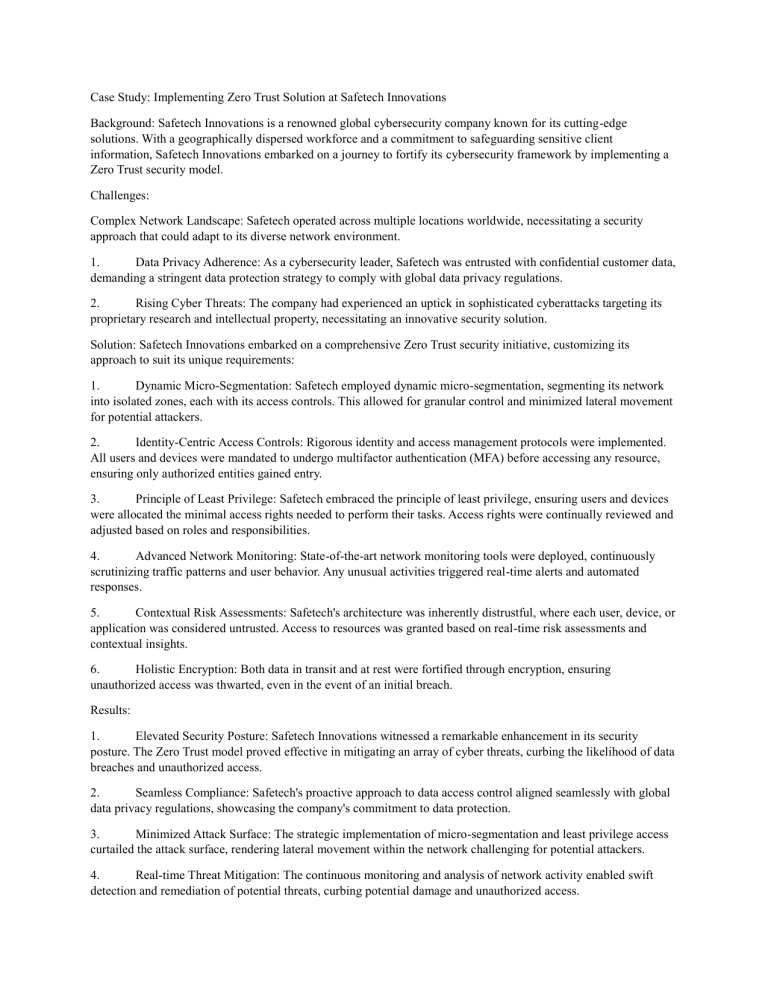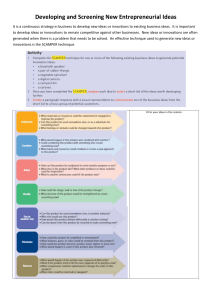
Case Study: Implementing Zero Trust Solution at Safetech Innovations Background: Safetech Innovations is a renowned global cybersecurity company known for its cutting-edge solutions. With a geographically dispersed workforce and a commitment to safeguarding sensitive client information, Safetech Innovations embarked on a journey to fortify its cybersecurity framework by implementing a Zero Trust security model. Challenges: Complex Network Landscape: Safetech operated across multiple locations worldwide, necessitating a security approach that could adapt to its diverse network environment. 1. Data Privacy Adherence: As a cybersecurity leader, Safetech was entrusted with confidential customer data, demanding a stringent data protection strategy to comply with global data privacy regulations. 2. Rising Cyber Threats: The company had experienced an uptick in sophisticated cyberattacks targeting its proprietary research and intellectual property, necessitating an innovative security solution. Solution: Safetech Innovations embarked on a comprehensive Zero Trust security initiative, customizing its approach to suit its unique requirements: 1. Dynamic Micro-Segmentation: Safetech employed dynamic micro-segmentation, segmenting its network into isolated zones, each with its access controls. This allowed for granular control and minimized lateral movement for potential attackers. 2. Identity-Centric Access Controls: Rigorous identity and access management protocols were implemented. All users and devices were mandated to undergo multifactor authentication (MFA) before accessing any resource, ensuring only authorized entities gained entry. 3. Principle of Least Privilege: Safetech embraced the principle of least privilege, ensuring users and devices were allocated the minimal access rights needed to perform their tasks. Access rights were continually reviewed and adjusted based on roles and responsibilities. 4. Advanced Network Monitoring: State-of-the-art network monitoring tools were deployed, continuously scrutinizing traffic patterns and user behavior. Any unusual activities triggered real-time alerts and automated responses. 5. Contextual Risk Assessments: Safetech's architecture was inherently distrustful, where each user, device, or application was considered untrusted. Access to resources was granted based on real-time risk assessments and contextual insights. 6. Holistic Encryption: Both data in transit and at rest were fortified through encryption, ensuring unauthorized access was thwarted, even in the event of an initial breach. Results: 1. Elevated Security Posture: Safetech Innovations witnessed a remarkable enhancement in its security posture. The Zero Trust model proved effective in mitigating an array of cyber threats, curbing the likelihood of data breaches and unauthorized access. 2. Seamless Compliance: Safetech's proactive approach to data access control aligned seamlessly with global data privacy regulations, showcasing the company's commitment to data protection. 3. Minimized Attack Surface: The strategic implementation of micro-segmentation and least privilege access curtailed the attack surface, rendering lateral movement within the network challenging for potential attackers. 4. Real-time Threat Mitigation: The continuous monitoring and analysis of network activity enabled swift detection and remediation of potential threats, curbing potential damage and unauthorized access. 5. Enhanced User Experience: Amid stringent security measures, Safetech Innovations prioritized user experience by enabling secure access from diverse devices and geographical locations. Conclusion: The triumphant adoption of the Zero Trust security model by Safetech Innovations underscores its effectiveness in fortifying cybersecurity defenses and preserving confidential data. By customizing its approach to focus on identity, access management, and continuous monitoring, Safetech Innovations has demonstrated its dedication to thwarting evolving cyber threats while maintaining operational efficiency.



